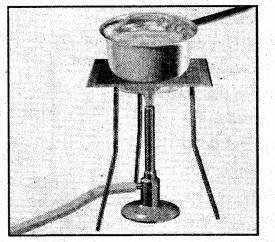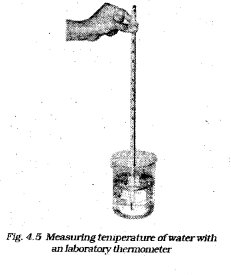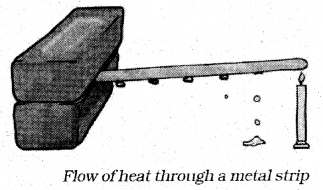Students can Download Chapter 4 Heat Questions and Answers, Notes Pdf, KSEEB Solutions for Class 7 Science, Karnataka State Board Solutions help you to revise complete Syllabus and score more marks in your examinations.
Karnataka State Syllabus Class 7 Science Chapter 4 Heat
Class 7 Science Heat NCERT Textbook Questions and Answers
Question 1.
State similarities and differences between the laboratory thermometer and the clinical thermometer.
Answer:
Similarities:
- Working principle of both the thermometer is same.
- Both are used to measure temperature.
- Mercury is used in both thermometers to measure temperature.
- Both have Celsius and fahrenheit markings.
- Both have a bulb at one end.
Differences :
- Laboratory thermometer is used to measure temperature of different objects in factories and laboratory where as clinical thermometer is used to measure the temperature of human beings only.
- Laboratory thermometer has temperature range from -10°C to 110°C where as clinical thermometer has temperature range from 35°C to 42°C.
- Clinical thermometer has a kink near the bulb while there is nokink in the laboratory thermometer.
(Due to kink mercury does not fall down on its own in clinical thermometer.)
Question 2.
Give two examples each of conductors and insulators of heat
Answer:
Conductors : copper, aluminium and iron.
Insulators : wood and plastic.
Question 3.
Fill in the blanks :
(a) The hotness of an object is determined by its Temperature.
(b) Temperature of boiling water cannot be measured by a Clinical thermometer thermometer.
(c) Temperature is measured in degree Celsius.
(d) No medium is required for transfer of heat by the process of Radiation.
(e) A cold steel spoon is dipped in a cup of hot milk. It transfers heat to its other end by the process of Conduction.
(f) Clothes of Dark colours absorb heat better than clothes of light colours.
Question 4.
Match the following :

Answers:
i – d,
ii – c,
iii – b,
iv – a
Question 5.
Discuss why wearing more layers of clothing during winter keeps us warmer than wearing just one thick piece of clothing.
Answer:
The air gets trapped between two layers of warm clothes. Air acts as insulator of heat. This layer prevents our body heat to escape in the surroundings. More layers of thin clothes will allow more air to get trapped and as a result we will not feel cold. So wearing more layers of clothing during winter keeps us warmer than wearing just one thick piece of clothing.
Question 6.
Look at Fig. 4.13. Mark where the heat is being transferred by conduction, by convection and by radiation.

Answer:
- Transfer of heat from hot plate to pan is by conduction
- Transfer of heat within water is by convection.
- Transfer of heat from hot bodies like pan, plate, burner etc. to the surroundings is radiation.
Question 7.
In places of hot climate it is advised that the outer walls of houses be painted white. Explain.
Answer:
In places of hot climate, it is advised to paint the outer walls of houses as white because a light colour such as white reflects back most of the heat that falls on it. We can say that it absorbs less amount of heat and keeps the house cool.
Question 8.
One litre of water at 30°C is mixed with one litre of water at 50°C. The temperature of the mixture will be
(a) 80°C
(b) more than 50°C but less than 80°C
(c) 20°C
(d) between 30°C and 50°C
Answer:
(d) between 30°C and 50°C
Question 9.
An iron ball at 40°C is dropped in a mug containing water at 40°C. The heat will
(a) flow from iron ball to water.
(b) not flow from iron ball to water or from water to iron ball.
(c) flow from water to iron ball.
(d) increase the temperature of both.
Answer:
(b) not flow from iron ball to water or from water to iron ball.
Question 10.
A wooden spoon is dipped in a cup of ice cream. Its other end
(a) becomes cold by the process of conduction.
(b) becomes cold by the process of convert
(c) becomes cold by the process of radiacios.
(d) does not become cold.,
Answer:
(d) does not become cold
Question 11.
Stainless steel pans are usually provided with copper bottoms. The reason for this could be that
(a) copper bottom makes the pan more durable.
(b) such pans appear colourful.
(c) copper is a better conductor of heat than the stainless steel.
(d) copper is easier to clean than the stainless steel.
Answer:
(c) copper is a better conductor of heat than the stainless steel
Class 7 Science Heat Additional Important Questions and Answers
Question 1.
Write a neat diagram of clinical thermometer and label the parts.
Answer:

Question 2.
Write the construction of clinical thermometer.
Answer:
A clinical thermometer consists of a long, narrow, uniform glass tube. It has a bulb at one end. This bulb contains mercury. It has a scale from 35°C to 42°C. This is Celsius scale, indicated by 0°C
Question 3.
What are the precautions should we take while using the clinical thermometer ?
Answer:
- Thermometer should be washed before and after use, preferably with an antiseptic solution.
- Ensure that before use the mercury level is below 35°C.
- Read the thermometer keeping the level of mercury along the line of sight. (Refer fig 4.3 in the text p.no. 37)
- Handle the thermometer with care. If it hits against some hard object, it can break.
- Don’t hold the thermometer by the bulb while reading it.
Question 4.
Why a clinical thermometer has a kink?
Answer:
In a clinical thermometer kink plays an important role. Kink prevents the mercury present in the capillary to fall back in the bulb. So it seprates the mercury at high temperature and cool mercury and allows the user to note the reading when the thermometer is taken out.
Question 5.
How do you measure the temperature of the person ?
Answer:
Wash the thermometer with an antiseptic solution. Hold it firmly, give it a few jerks. The Jerks will bring the level of mercury down. Ensure that it falls below 35°C. Now place the thermometer under the tongue of the person. After one minute take the thermometer out and note the reading. This is the temperature of that person. The temperature should always be stated with its unit °C.
Question 6.
How do you measure the temperature of the liquid ? Draw the neat diagram and Label the parts.
Answer:
Take the liquid in a beaker. Dip the thermometer in the liquid so that the bulb is immersed in the liquid but does not touch the bottom or the sides of the container. Hold the thermometer vertically.

Observe the movement of mercury in the thermometer, wait till the mercury thread becomes steady. Note the reading. This is the temperature of the given liquid at that time.
Question 7.
Draw a neat diagram and explain the flow of heat through a metal strip.
Answer:

Take a rod or flat strip of a metal. Fix a few small wax pieces on the rod. These pieces should be at nearly equal distances. Clam the rod to a stand or place one end of the rod in between two bricks. Heat the other end of the rod by a candle. Observe. The heat from the candle side passes towards the other end by dissolving wax pieces on the rod. This experiment shows that heat is transferred from the hotter end to the colder end.
Question 8.
Define Conduction.
Answer:
The process by which heat is passed from the hotter end to colder end in solids. This is known as Conduction. All metals are good conductors of Heat.
Question 9.
Define Convection with an experiment.
Answer:
Take a round bottom flask. Fill it with \(\frac{2}{3}\) part of water. The other equipments should arrange as in the figure. Heat the water by placing the candle just below the flask. Observe when water is heated near the flame gets hot and rises up. The cold water from the sides moves down towards the source of heat. This process continues till the whose water gets heated. This mode of heat transmission is known as Convection.
Question 10.
Define radiation with an example.
Answer:
The transfer of heat without any media is called Radiation. When we sit in front of a room heater, we get heat by radiation. The Sun heat is also transfer through radiation because most part of the space between the earth and the Sun there is no media or air.
Question 11.
What are Conductors ? give example.
Answer:
The materials which allow heat to pass through them easily are Conductors, eg : All metals.
Question 12.
What are Insulators ? Give example.
Answer:
The materials which do not allow heat to pass through them easily are poor conductors or insulators. Eg : Wood, plastic etc.,
Question 13.
Define Sea breeze.
Answer:
During the day the land gets heated faster than the water. The hot air rises up and cooler air from the sea rushes towards the land. This is called the Sea breeze.
Question 14.
Define Land breeze.
Answer:
At night the water cools down more slowly than the land. So the cool air from the land moves towards the sea. It is the land breeze.
II. Fill in the blanks :
1. The normal temperature of human body is 37°C.
2. The clinical thermometer is used to mea sure the temperature of human body only.
3. The digital thermometer do not use mercury.
4. Poor conductors are known as insulators.
5. Heat is always transfer from hot, bodies to cooled bodies.
6. Black or Dark coloured objects absorbs more heat.